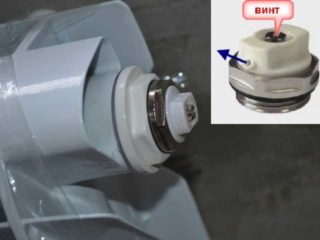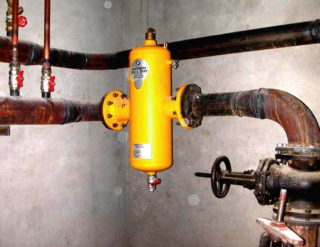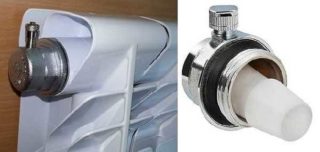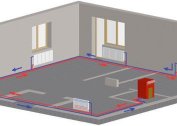The water heating system is able to work correctly only if there is no air in it. It periodically enters the circuit and, gradually accumulating, creates difficulties for the circulation of the coolant. It is impossible to prevent the ingress of gas, but you can remove it in time. For this, an air collector is used for the heating system.
Features of design and operation
When a heated water stream begins to slow down its speed, a volatile mass begins to stand out from the liquid. At this time, it is convenient to remove air from the heating system. Therefore, all capture units have the shape of a container in which as much of this substance as possible can fit.
The second condition - the design and installation position of the device are chosen so that the flow inside the device slows down its speed. As a rule, the most suitable mounting point is at the highest point of the heat line.
Types of devices with different operating principles
After separation and accumulation in the tank, the gas must be driven out. For this, one air trap is not enough; removal devices are needed. Such elements mean special plumbing mechanisms - air vents. They are mounted directly on the device.
There are two types of such devices: some operate in manual mode, others automatically discharge gas.
Automatic bleeding mechanisms
At the points of greatest probability of gas accumulation in the pipes, automatic elements are installed to remove it. Typically, these places can be sharp bends of pipes, changing the direction of movement of the coolant from top to bottom or any other upper points. There is also an automatic air vent for the radiator.
Manual gas removal from the warm circuit
Manual action valves supply all heating radiators. It is more expedient to do this because of the relative cheapness of such elements and the absence of the risk of the entire boiler house shutting down if one of the convectors becomes airy and ceases to function.
Using manual air vents, you can bleed air from the heating radiator immediately after starting the boiler equipment or restarting during repair.
Types of air collectors
Based on the principle of installing the air intake in the system, allocate:
- flowing devices;
- non-flow type devices.
Both of them have the form of a cylinder with smooth or elliptical ends with a diameter greater than the diameter of the pipe into which they are directly embedded. In internal design, they may vary slightly, but the principle of operation is the same.
Flowing
Such elements are directly installed in the section of the supply and return pipes of the boiler house. Through the structure, fluid is constantly forced into the pump by force. Air, gradually released from the water, leaves through the vent. The advantage of the system is that the entire volume of the coolant passes through the trap, so a large percentage of the gas can be removed. The second plus is the protection of the unit from freezing due to the continuous movement inside it. It is possible to install an air collector indoors without heating.
Leaking
Non-flowing units are freestanding elements that are cut into a line with only one end, usually located on top. Bubbles rush into them through the nozzle. In this case, there is a likelihood of a worse cleaning of oxygen, if the speed of the coolant is high enough and not all bubbles can separate in time from the total mass and get into the air intake. Another inconvenient point is the risk of freezing of such a container in the winter, so its installation must be carried out in a heated room.
The principle of separation of the gaseous mass from the coolant
Air is dissolved in water when it has a low temperature. As the circuit warms up, oxygen begins to be released, uniting into bubbles. They are in the coolant flow and occupy the upper space due to the lighter weight. At the moment of transition from a thin pipe to a thick fluid velocity drops, giving the bubbles the opportunity to snuggle up to the upper wall of the channel. On this principle, the separation of matter occurs.
Vertical Separator
In appearance, this cylinder resembles an expansion tank. Such a separator is used in a two-pipe system where there is a vertical riser. This flowing device is installed at the highest point of the pipe with a minimum velocity of the coolant. Entrance and exit goes from the bottom, there is also a pipe with a thread for the trigger. The separator is equipped with a drain valve or an automatic gas vent.
If a manual valve is installed for oxygen removal, it is necessary to periodically check the separator so that it is not completely filled with volatile matter and does not cause an air plug.
Horizontal Separator
The horizontal unit is often used for single-pipe circuits. Embed it in series with radiators before or after the boiler. This cylinder has a diameter larger than that of the supply pipe. Due to its size, the liquid slows down the movement. A manual or automatic air vent is also installed in the upper part of the element; inlet and outlet are located at both ends of the cylinder. For such a mechanism, it does not matter that its location is at the top point.
Automatic valve
The mechanism has a small internal capacity, in which there is a float, a lever and a nipple valve. All these elements are interconnected. If there is water in the chamber, the float is raised up and the lever keeps the nipple valve closed. As soon as the gases enter through the connecting pipe, the float lowers and pulls the lever down under its weight - the valve bleeds air.
Manual crane Majewski
This element helps to release air from the battery. It is installed mainly at the top of the radiators. Reset occurs when the needle valve is loosened. You need to use the device every time after restarting the system, or when the convector is cold for some reason.
Water-folding cranes
Conventional ball valves are sometimes used to bleed air. They are easy to use, reliable, but you need to be careful when opening such a faucet - the large diameter of the passage channel contributes to the rapid bleeding and the same rapid splashing of hot water under pressure.







